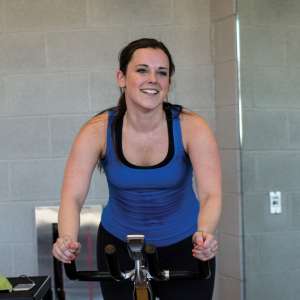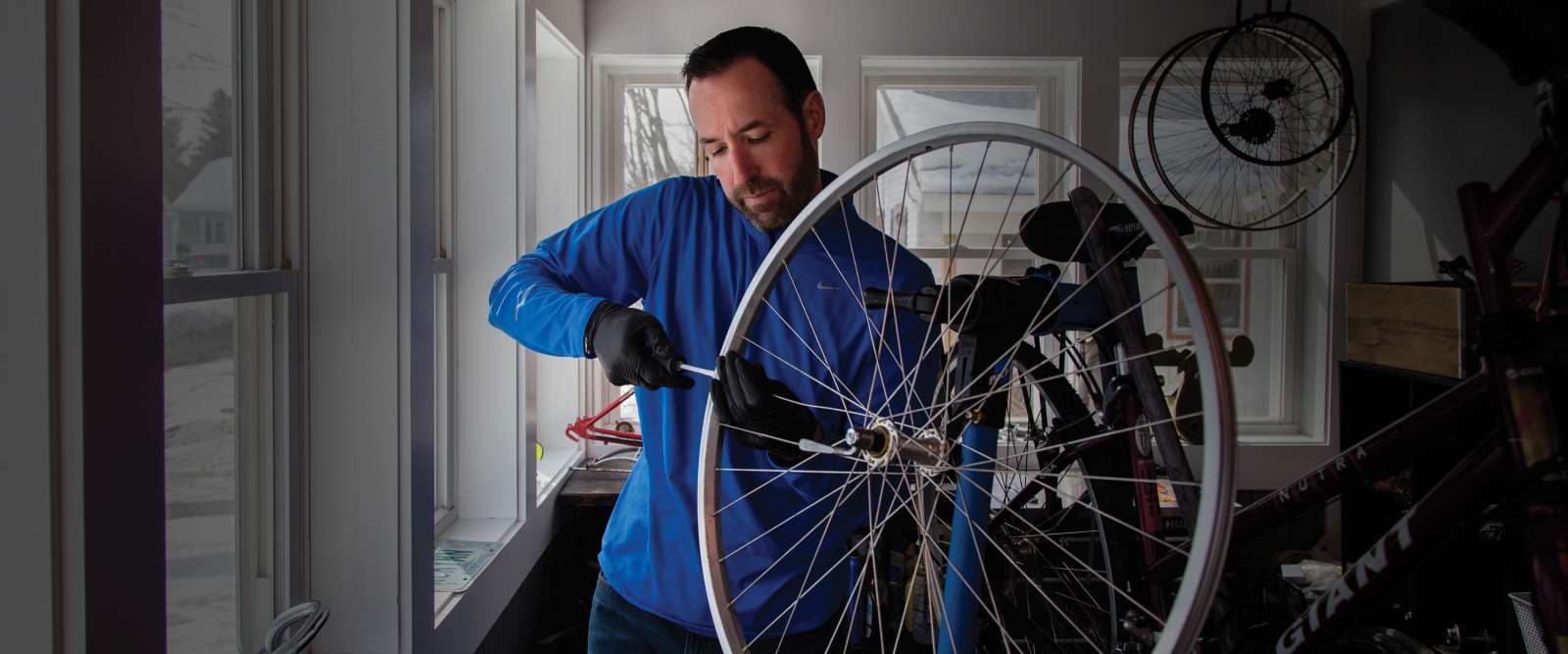
Spring 2015: The Wellness Issue
It’s not just about physical fitness and eating right, though those are key pieces. This issue of Keene State Today looks at a whole spectrum of elements that factor into personal well-being – and then takes a broader look at the role wellness plays in society. You’ll meet a 1959 grad who runs marathons, a nontraditional student who interns at the Cheshire County jail, two active centenarians, and more.
Features





Online Extras
Mindful Stress Reduction
14 Ways to Reduce Stress During the Day
- Take breath breaks during the day – these can be as short as one breath to one minute to just stopping and paying attention to breath, body, and mind.
- In the morning, when you wake up or before you start your day:
- Set an intention for the day – to slow down, to remember to stop, to be thankful.
- Take a few minutes to be quiet or meditate or take a slow walk.
- Take a few minutes to read something that inspires you.
- Take a few seconds to quietly pay attention to your breathing before you turn on the car (or leave your room) before coming to work or in the parking lot before you get out of your car (or enter the room of your destination). This can also be done at the end of your work day.
- Pause for a few seconds to see and to appreciate the beauty you see.
- When you sit down to type on the computer, take one slow breath before you start.
- While sitting at your desk, occasionally pay attention to bodily sensations. When we bring a curious and gentle mind to our bodily sensations, the body naturally relaxes.
- During the day, notice when you are rushing. What does this feel like in your body, in your breath? What can you do about it? We’ve got more control than we realize.
- Use the everyday cues in your environment – the telephone ringing, sitting at the computer, waiting in line, waiting at a stop light, etc. – as reminders to take a breath to “center” yourself.
- Wear a bracelet, necklace, or ring that reminds you to breathe, to appreciate life.
- When choosing passwords on your computer, think of ones that might serve as reminders, such as Slower12, Breathe12, Smile 12, etc.
- Look for opportunities to smile. Benefits include: smiling changes your mood, it’s contagious, it relieves stress, boosts immune system, lowers blood pressure, releases endorphins and natural pain killers, and helps you stay positive.
- Choose to eat a snack in silence, or just savor the first few bites. Use this as a time to eat slowly and be with yourself.
- Before and after using cell phones, email, or social media like Facebook, check in with your body and breath. Many have noticed tension before and after using various technologies.
- Add your own!
Adapted from a longer handout from Jon Kabat-Zinn’s program.
Places within 1 hour of Keene to practice and study meditation Monadnock Mindfulness Practice Center 103 Roxbury St. Suite 301, Keene Monday, Tuesday, & Thursday 6:30 - 7:30pm, Wednesday 8-9 am. Mindful Yoga Friday 5 – 6:15. Tom Bassarear (tbassare@keene.edu) has a book study group on Monday night after sitting.
Vermont Insight Meditation Center in Brattleboro, VT Solar Hill at 229 Western Avenue, Brattleboro, Vermont Sunday Sitting Group 10am – 12 pm, Tuesday & Thursday 7 – 7:45 am.
Morning Sun Mindfulness Community Michael and Fern lived with Thich Nhat Hanh’s community in France for quite a few years. There are regular Sunday gatherings including pot luck lunches and regular gatherings for parents. 776 Gilsum Mine Road, Alstead, 603-357-2011
Foundation for Active Compassion Practice Group in Putney, VT Location: The Friends Meeting House in Putney, VT. Tuesdays, 7-8 p.m. 802-387-5010
Mountains and Rivers Mindfulness Community Meditation Practice in the tradition of Thich Nhat Hanh Mondays 7–9 p.m., Friends Meeting House, Route 5, Putney, VT Fridays 7:30–8:45 a.m., Biologic Integrative Healthcare, LLC, 205 Main Street, Brattleboro Richard Brady, Elisabeth Dearborn, 802-387-2382
Wonderwell Mountain Refuge 253 Philbrick Hill Road, Springfield, NH 03284, 603-763-0204
Websites For guided meditations: Harvard Pilgrim’s mindfulness page: Click on “For work or home” and listen to any of the guided meditations. Tom Bassarear’s recorded guided meditations
Books Each of these books focuses on short mindfulness practices that one can do during the day: How to Train a Wild Elephant and Other Adventures in Mindfulness by Jan Chozen Bays, just ONE thing: developing a Buddha brain one simple practice at a time by Rick Hanson, and One Minute Mindfulness by Donald Altman. Wherever You Go, There You Are: Mindfulness Meditation in Everyday Life, John Kabat-Zinn. This book goes more deeply into the practice of meditation and applying these practices to daily life. When Things Fall Apart, The Places That Scare You, Pema Chodron. How to Meditate is a comprehensive and very readable book on the basics of mindfulness meditation. Creating True Peace: Ending Violence in Yourself, Your Family, Your Community, and the World, Thich Nhat Hanh This book collects some of his most well-known and helpful stories and practices. Anger: Wisdom for Cooling the Flame. A practical and effective book toward dealing with this emotion. The Force of Kindness: Change Your Life with Love and Compassion and Real Happiness: The Power of Meditation: A 28-Day Program. Sharon Salzberg lays out the loving-kindness practice. Meditation for Beginners. Jack Kornfield. This is a great book for beginners. Buddha’s Brain: The Practical Neuroscience of Happiness, Love and Wisdom by Rick Hanson. A fascinating book talking about connections between Buddhist psychology and neuroscience.
Tips for Staying Active with a 9-5 Desk Job
Stuck behind a desk? Here are some great suggestions from Dianna Sinni ’10, a registered dietitian, wellness nutritionist, and whole food blogger whose “grab and go” recipes can be found on page 7 of Keene State Today’s Spring 2015 issue. You may want to check out Sinni’s food blog, Chard in Charge, too.
- For every hour you sit at your desk, get up and walk for five minutes. This helps to get the blood flowing and prevent your muscles from cramping after being in one position for an extended period of time. So take that extra run to the copier or walk around the cubicles twice before stopping in for your next meeting.
- Take a lunch break! Break free from your computer or desk and allow yourself to eat in a quiet place away from a screen, even if only for ten minutes. Give yourself a quick “recharge” away from your work and take in a new scene, even if it’s only the parking lot.
- Sit with good posture. Not only does this strengthen your back and shoulder muscles and prevent future spinal problems, but it’s a whole lot easier to work when you aren’t hunched over your desk. Ask your employer to have your workspace ergonomically evaluated – you work there for eight hours a day, so it should be comfortable and appropriate for your body.
- Take the stairs! Climbing is a quick way to get in some cardio during your day and burn extra calories throughout the year.
- Stretch. Do some simple spinal twists while seated in your desk chair. Try a standing forward fold or shoulder/neck rolls. Frequent movements can help negate the effects of sedentary lifestyles.
– Dianna Sinni ’10
Healthy Relationship Tips
- Keep the relationship interesting by increasing the quantity & quality of time spent together. Be polite to your partner and share with them your appreciation for the large and small things they do for you. Relationships require sustained effort to maintain satisfaction and growth. If you’re a dancer or you play a sport such as tennis, you don’t expect to get better at these things without sustained effort and occasional feedback. Our satisfaction in romantic relationships will stagnate too if we don’t put in constant effort.
- Alternate days when one partner does something nice for the other.
- Help your partner through the emotional “baggage” of prior relationships. People feel closer to others when they help them resolve painful experiences. Your options are to either complain about your partner’s “issues” or help your partner and feel closer for it. Although the option of helping may seem exhausting, the choice seems obvious when considering the end result!
- Identify your strategies for feeling close to your partner and determine if they can have unintended negative consequences. For example, if someone had to over-extend herself to feel appreciated by a former partner who was emotionally distant, and she carries this “style” into a new relationship, then the new partner may become annoyed by this “extra” effort or even may take advantage of this person’s selflessness.
- Identify your underlying expectations, standards, and assumptions about your partner and romantic relationships. Throw out the ones that are problematic, those that can distort our experience with our partners and cause us to behave in destructive ways. For example, people learn from various experiences about how a relationship “should” be. These basic philosophies for a relationship aren’t always accurate or realistic.
- Deal with conflicts as soon as possible. Holding grudges for too long can infiltrate other areas of life and affect other parts of the relationship not even related to the original conflict.
- Express your feelings openly. Couples that openly express their feelings report feeling closer to their partners.
- When discussing a problem, use the X-Y-Z technique. Speak for yourself and not for your partner by using “I statements” that follow the following format: “I feel X when you do Y in Z situation.” Then give your partner a chance to respond. Remember to stick to the facts and that each partner can only speak for him or herself.
- Never engage in “mind reading.” Assuming we know what our partner thinks, feels, or means will lead to problems. Never assume and always ask!
- Continuously maintain an open channel of communication. Always include your partner in your struggles, concerns, decisions, questions, desires, insecurities, worries, and everything else you experience!
– Provided by Brian D. Quigley, Ph.D.
Live Long and Prosper
Links to More Information
Features
- Learn about Keene State’s Summer Undergraduate Research Fellowships (SURF)
- Learn more about Seacoast Eat Local
- Find information on the Keene State Dietetic Internship program
- Read more about the Rwanda healthcare project
- Link to dietitian and yoga instructor Cait Croteau’s website
Faculty-Staff Accomplishments
- Read the Q&A with Jack Fabian on the USA Swimming site
- Read more about James Waller’s role in the 20th commemoration of the Srebrenica genocide
- Learn more about donating to Keene State
Class Notes
